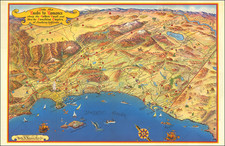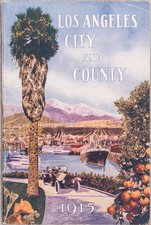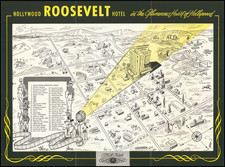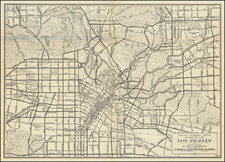One of the First Zoning Maps for Beverly Hills
Detailed map of Beverly Hills, prepared by the City of Beverly Hills Engineering Department under the direction of William R. Metz, City Engineer.
Published 22 years after the incorporation of Beverly Hills as a city, the map likely depicts the earliest zoning map issued by the city.
The map is oriented with northwest at the top, and shows the City of Beverly Hills is laid out in exacting detail, with color coding for 5 different usages:
- Red - Residential R-1
- Blue - Residential R-1.5
- Green - Residential Income R-4
- Yellow - Business C-3
- Brown - Industrial M-2
- White - Public Property and Lots Not Zoned
The Rail line on Santa Monica Blvd is shown, splitting into two lines at Beverly Drive. Street names, lot numbers and tract map numbers are shown. A High School Site is shown, along with several larger undeveloped tracts.
The map was drawn by Carlos Valle-Riestra. Born in Lima, Peru in 1892, he was educated at the University of San Marcos as a mining engineer. Valle-Riestra would go on to serve as City Engineer of Beverly Hills until his retirement in 1962. Carlos Valle-Riestra's name would continue to appear on later editions of the map until at least the January 1961 edition.
This is the earliest surviving zoning map of Beverly Hills which we could locate. The population of Beverly Hills was 674 in 1920 and the town did not have a post office until 1934.
Beverly Hills
The area was settled by Maria Rita Quinteros de Valdez and her husband in 1828. At the time, the area was Rancho Rodeo de las Aguas. In 1854, she sold the ranch to Benjamin Davis Wilson (1811–1878) and Henry Hancock (1822–1883). By the 1880s, the ranch had been subdivided into parcels of 75 acres and was being rapidly bought up.
Henry Hammel and Andrew H. Denker acquired most of the land and used it for farming lima beans. The area became known as the Hammel and Denker Ranch. By 1888, they were planning to build a town called Morocco on their holdings.
n 1900, Burton E. Green, Charles A. Canfield, Max Whittier, Frank H. Buck, Henry E. Huntington, William G. Kerckhoff, William F. Herrin, W.S. Porter, and Frank H. Balch formed the Amalgamated Oil Company, bought the Hammel and Denker ranch, and began looking for oil, but their finds were not sufficient to justify further drilling. In 1906, the group reorganized as the Rodeo Land and Water Company and renamed the property "Beverly Hills," subdivided it, and began selling lots.
The Los Angeles Times reported on September 2, 1906:
Percy H. Clark Company are managing the development of the foothill portion of the Hammel & Denker ranch for the Rodeo Land and Water Company (the Canfield-Huntington-Kerckhoff syndicate), to be known as Beverly Hills. No expense is being spared to make this a fine suburban district. . . . The property has been laid out on beautiful curved lines.
Beverly Hills was incorporated as a city in 1914. It was one of many all-white planned communities started in the Los Angeles area around this time. Restrictive covenants prohibited non-whites and Jews from owning or renting property unless they were employed as servants by white residents.
In 1919, Douglas Fairbanks and Mary Pickford bought land on Summit Drive and built a mansion, finished in 1921. The glamour associated with Fairbanks and Pickford as well as other movie stars who built mansions in the city contributed to its growing appeal. Will Rogers, a wise cracking political humorist, became honorary first mayor of Beverly Hills. Rogers went on to play a part in the development of Beverly Hills by fostering construction of a new City Hall in 1932 and the establishment of a U.S. Post Office in 1934.
Rarity
The map is unrecorded. We were unable to find any other examples.
The earliest zoning map of Beverly Hills listed in OCLC is a 1945 copy held UCLA. UCLA also holds 2 later editions of the map, the last dated January 1961.














![[ La Puente ] Geological Survey Los Angeles County Puente Quadrangle](https://storage.googleapis.com/raremaps/img/small/82489.jpg)